Victoria here, delighted to hear that the William Morris Gallery in Walthamstow, part of northeast London, reopened last month (August, 2012) after a £5m ($8.1m) renovation. I visited the museum a few years ago as an admirer of Morris and his many activities, so an upgrade is welcome news. The website of the museum is here. The museum is operated by the Waltham Forest Council and received assistance from the Heritage Lottery Fund.
William Morris, age 53, photo by Frederick Hollyer
Artist and designer, Visionary and cultural innovator, publisher and writer of prose and poetry, socialist thinker and political theorist, entrepreneur and mentor — William Morris was one of the leading figures of the late Victorian period. He was an influential member of the Pre-Raphaelite Brotherhood and founded the Arts and Crafts Movement, both with enduring international influence.
Tapestry: Dreams from Industrial London
The Economist magazine wrote (More than Just a Pretty Swatch: Homage to a Colourful and Complex Victorian Polymath) recently of the museum’s renovation, here. In addition to a collection of more than 10,000 Morris objects, the museum runs education programs, exhibitions of contemporary artists, and many more events, not to mention (naturally) the SHOP and the tea room.
I fell in love with William Morris Designs — fabric, tapestries, wallpaper, etc. — long before I even knew his name. His art simply spoke to me on a personal level.
If you are a William Morris fan, come along with Kristine and me to Liberty of London on Regent Street …
Liberty, Regent Street
…where we have been known to leave more pounds than we should have! I like it so much I’ve spent a few hours at home replicating it for my wall — and Kristine’s
counted cross stitch Liberty
A current exhibition at the Tate Britain explores the Pre-Raphaelites: Victorian Avant-Garde through January 13, 2013. The artworks of Dante Gabriel Rossetti, Sir John Everett Millais, William Holman Hunt, Edward Burne-Jones, William Morris and others are included.
I fear I shall have to miss this excellent show, as I will not be in London before next spring. Boo-hoo. But I have seen many of the pictures and other objects before. The Delaware Art Museum in the U.S. has an excellent collection of Pre-Raphaelites which I have visited. Some are included in the Tate exhibition.
Peacock and Bird Carpet by Morris, Wm. Morris Gallery
In addition to the Walthamstow Gallery, in which William Morris lived from age 14 to 22, and the Tate Exhibition, two other National Trust buildings associated with William Morris are open to the public, but be sure to check for limited availabilities.
The Red House, NT
Morris co-designed The Red House in Bexleyheath, southeast London, for his wife, Jane Burden, and family. Once in the country and surrounded by orchards and pastures, it is now in the busy suburbs. Jane and William had two daughters, but lived here only five years, moving due to financial problems. It is being restored to its original condition. Jane often posed for Morris, and his only existing easel painting, below, now in the Tate Gallery, portrays her.
La belle Iseult, 1858
Jane also posed for other Pre-Raphaelites, especially for Rossetti, with whom she had a long affair, though she and Morris never divorced.
Water Willow, by Rossetti, 1871; Jane Burden Morris, with Kelmscott Manor in the background
After 1971, Morris and his family spent time at their country house, Kelmscott Manor, now open to the public on some days during the summer. It is operated by the Society of Antiquaries of London.
Kelmscott Manor, Oxfordshire
The original house dates from 1570 and was both a design project and an inspiration for Morris and his friends. The website
is here. The house includes furnishings and textiles designed by Morris, in addition to changing exhibitions and a lovely garden. William Morris is buried in the nearby village churchyard.
Now all I (we) need is unlimited time to wander about England. Let’s go.




_London_UK.jpg)





